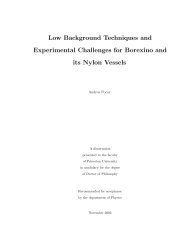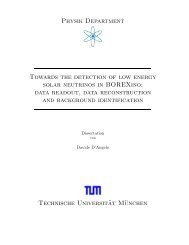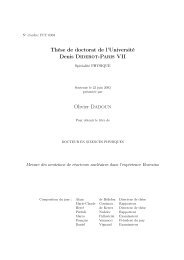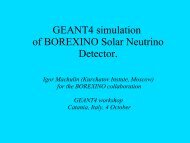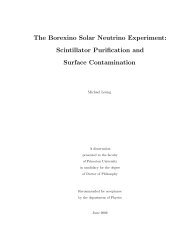Development of a Liquid Scintillator and of Data ... - Borexino - Infn
Development of a Liquid Scintillator and of Data ... - Borexino - Infn
Development of a Liquid Scintillator and of Data ... - Borexino - Infn
You also want an ePaper? Increase the reach of your titles
YUMPU automatically turns print PDFs into web optimized ePapers that Google loves.
Summary <strong>and</strong> Outlook<br />
possible to distinguish clearly between the different currently allowed oscillation scenarios.<br />
The LENS experiment aims at a real-time charged current detection <strong>of</strong> the Be <strong>and</strong>, eventually<br />
the pp neutrinos. By measuring the CC <strong>and</strong> the neutrino-electron scattering (CC + NC)<br />
rate <strong>of</strong> the Be neutrinos, their total flux can be determined <strong>and</strong> compared with solar model<br />
predictions. The comparison <strong>of</strong> the results from BOREXINO <strong>and</strong> LENS can then give an unambiguous<br />
pro<strong>of</strong> for oscillations <strong>of</strong> the Be neutrinos.<br />
The identification <strong>of</strong> the neutrino signal in BOREXINO relies on the distinction <strong>of</strong> a Comptonlike<br />
edge in the electron energy spectrum, due to the monoenergetic (862 keV) Be neutrinos<br />
scattered <strong>of</strong>f electrons. Since the neutrino signal does not have any event-by-event signature,<br />
reduction <strong>and</strong> rejection <strong>of</strong> the background signals from radioactive decays are essential. As<br />
the expected signal rate in BOREXINO is less than ÓÙÒØ× ØÓÒ ¡ Ý in the energy range<br />
from 0.25 - 0.8 MeV, the requirements on the radiopurity <strong>of</strong> the detector components are extremely<br />
challenging: for the liquid scintillator, a maximum concentration <strong>of</strong> U <strong>and</strong> Th<br />
<strong>of</strong> g/g <strong>and</strong> <strong>of</strong> K<strong>of</strong> g/g is allowed in order to achieve a signal/background ratio<br />
even in the case <strong>of</strong> total conversion <strong>of</strong> into . The necessary background suppression<br />
can be achieved only if a large fraction <strong>of</strong> the background events can be rejected by their pulse<br />
shape characteristics (alpha decays) <strong>and</strong> by spatial cuts (discrimination <strong>of</strong> external background<br />
by fiducial volume cut). It is therefore crucial to provide several independent analysis methods<br />
which can be used for cross checks <strong>of</strong> the efficiency <strong>and</strong> systematic uncertainty <strong>of</strong> the applied<br />
cuts.<br />
In this work, a new method for the spatial reconstruction <strong>of</strong> scintillation events for BOREXINO<br />
<strong>and</strong> the CTF was developed <strong>and</strong> successfully tested with Monte Carlo simulations <strong>and</strong> CTF2<br />
data. From laboratory measurements <strong>and</strong> source tests in the CTF1, the parameters for an optical<br />
model <strong>of</strong> the light propagation in the liquid scintillator have been evaluated <strong>and</strong> applied in<br />
a tracking program developed for BOREXINO <strong>and</strong> the CTF. The reconstruction compares the<br />
ADC <strong>and</strong> TDC data from a real event with values from simulations on a spatial grid. The resolution<br />
<strong>of</strong> this reconstruction method therefore depends strongly on the underst<strong>and</strong>ing <strong>of</strong> the<br />
light propagation mechanisms. Calibration measurements with localized sources in the CTF2<br />
were performed in order to study the systematic behaviour <strong>of</strong> the reconstruction code.<br />
A new liquid scintillator based on phenyl-o-xylylethane (PXE) was tested as an alternative<br />
choice for BOREXINO. Its physical <strong>and</strong> chemical properties make it superior to pseudocumene<br />
(PC) in some respects, e.g. the higher density (target mass) <strong>and</strong> the higher flash point (safety),<br />
but there are also some limitations which need further investigation. In particular, the C<br />
concentration was about 6 times higher than in the PC measured in the CTF1 ( C/ C <br />
¡ ). The C level may vary, though, depending on the petroleum source, <strong>and</strong> also for<br />
the PC a new batch <strong>of</strong> scintillator from another source could have a higher C/ C ratio.<br />
The very low U concentration that was measured in PXE by NAA ( ¡ g/g) could<br />
not be confirmed by CTF measurements, as in the CTF1 the sensitivity <strong>of</strong> the detector was<br />
substantially reduced due to the failure <strong>of</strong> a large fraction <strong>of</strong> the PMTs, <strong>and</strong> in the CTF2 a<br />
Rn background <strong>of</strong> the order <strong>of</strong> several g/g from an unidentified source was present.<br />
The Th concentration measured in the CTF2 ( ¦ ¡ g/g) is compatible with the<br />
limit <strong>of</strong> ¡ g/g that was measured with NAA, confirming the high intrinsic radiopurity<br />
114



